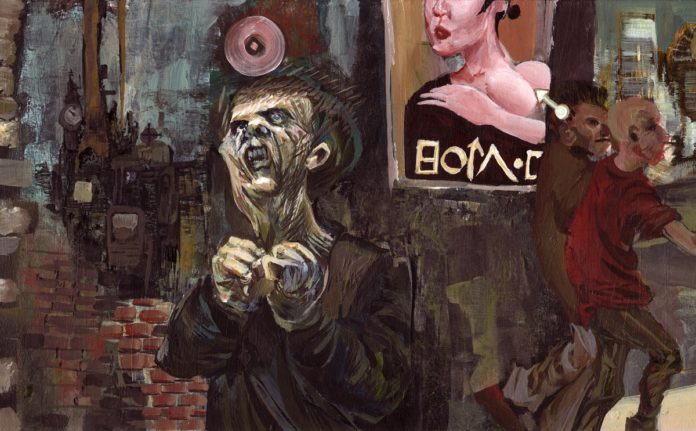I wish I could put neckties in the wash. It is pointless to talk about it now. On a whim, that was exactly what I did, and now I have a hamper-full of ruined ties.
I have become the kind of guy that wears nothing if it does not have space for a necktie. There is a certain way I put myself together, and there are thoughtful reasons for this.
I used to work with a guy who was informing the group at the office that formal dress had its perks. The necktie, according to him, is to cover up the paunch. He was convinced of this, and yet there was no necktie made that could cover this man’s stomach. He was shaped like a skinny person who had half his weight accumulate in the middle front section of his body.
He obviously had it wrong. A necktie, if it had any illusionistic uses, was not to cover anything but to redirect attention. That thin, decorative line that goes down the front of your torso was made to place an accent under the head and neck and perhaps to provide a distraction from less attractive abdominal features.
For me, however, the necktie was never about that. It was something more subtle or maybe something that is so obvious, it is hardly worth mentioning. The necktie hid my identity under a bland look, a mode of dress that felt universally acceptable. No one bothered to take notice of such conventions in a man looking as if he were going to work, so it blended into the background.
Without following conventions too rigidly however, I wear shirts and neckties in a particular way. The newsroom look of old TV is over, but I go after the look that refers to the end of the day at the newsroom, worn by the kind of guy who has put in most of his hours at work and is just sick of the tie. So he loosens it and rolls up his shirtsleeves ready for even more tangle, for he is a man of action who still keeps a sense of professionalism by using the wardrobe of expectations to play the part.
The thing is I don’t resort to this look at the end of the day but employ it right at the beginning, and I have almost nothing in common with those old news hounds. But I identify with the look because it is the only one that now works for me. I prefer the half-Windsor knot over the other tie knots because it has an edge of the incomplete, and when you take it off, you have to unravel it multiple times to get the spirals out of it. In some ways, the four-in-hand works even better than the half-Windsor for that asymmetrical, loose appearance. A loosened tie under the unbuttoned collar is a lot easier on the neck. Rolled up sleeves require no ironing because half the sleeve is gone from view and the other half is crowded by the rolled up fold. The necktie takes the focus off the center of the front of the shirt, and the back shirt does not matter. So, if any wrinkles make it through this defense, they cause minimal alarm.
I guess I’m practical. When I had long hair, I was giving people a map legend to my characteristics, and they would take in this information and warm up to it or not. From a guy who wears a tie everyday — who wears it even to do his writing at home and sometimes forgets it’s on when cleaning the kitchen or taking care of a filthy garbage can — people pick up little more than a clean slate. This guy could be anybody. I’m giving people no stance with which to hold on, and I am letting them come up with their own conclusions if they have any.
A tie could raise certain stereotypes as easily as any mode of dress, but I feel that by tweaking my necktie habits with those newsroom features, I am giving them more at the same time that I’m giving them less. It is more because they are added details, and it is less because I am obviously not a businessman or lawyer or some small-time politician. So, what could I be?
Few people would be able to guess that I am an artist. I am the type of person that makes paper out of layers of paint and then draws on it with the same kind of paint and finally attaches it onto a panel to express himself and hopefully have others engage with it. I like that I am undercover because the assumptions people will have on me are going to be vague.
It helps that when I think about my look, I don’t give it more than the couple of minutes it takes to put on my tie. I don’t have to put my wardrobe through one of those major facelifts. I am content looking how I’ve been looking for these past years, allowing me to spend my creative contemplations on my art rather than myself.
How many artists have sought to live the life artistic, cramming all of their concentration on the appearance and little on the actual work? I am talking about the people that prefer to be seen as artists than to actually be artists. I used to be like that. I used to spend lots of time finding out who I was and what was the best way to express that in my look. Back in those days when my mind was occluded with the thought of every young lady I fancied, I was convinced that such young ladies preferred this creative, rebellious look over something like a shirt and tie. I would seek out outlandish clothes to appropriate the artistic sense. It took a long time to concoct who I was by how I dressed, deliberating over what types of clothing were the real me and which were the farthest thing from me. It all took time. Long, curly hair takes a lot of maintenance. So does well-groomed facial hair that creates patches of tufts on chin and mustache, on sideburns and soul patch. When you come up with a roving, elaborate wardrobe, it might take some moments of your day just to think about how you’re going to put yourself together. I was just like that.
The secret identity is one of those story themes that I could just not live without. While working at a teaching job, where I was forced to wear such things as ties and blazers, I’d tie my unruly hair up and take off the large hoops from my ears, and I’d pretend to be someone respectable. I felt comfort in knowing what no one in that class full of hot young ladies knew — that I was one of the fallen, a creature of the night, with powers of mystery allied to insatiable appetites.
I recall one young lady who thought I was straight-laced and would say I was such a nice guy. She only knew me at the workplace. And that only meant she didn’t know what I really looked like. When I was out on the street on a Saturday with my hair down, wearing my leather jacket and shades, I would walk past people I knew from the same workplace, and they would be looking at me right in the face, and they had no idea it was me. When I eventually went out with this girl, meeting her at a corner cafe, the look on her face said it all. That moment when you create that reaction in someone else was a real thrill! It was what I lived for.
That was the secret identity I held just for myself. It proved to grant years of fun, until I got bored with it. If the girl that got close to you learned your secret, she was in on the fun. With time, she couldn’t get enough of your unique insanity. She thought you were special and she would laugh when she would equate the two versions of you and actually witness the reactions in others when we would bump into them at a bar. At some point, I concluded that exhibiting every aspect of yourself to a person you’ve known for two months was not that interesting. The desired shock value had been disarmed.
And then one day, you start to become the butt of every one of her jokes. Now that she knew you, the mystery gave way to comedy, and this bright young lady would bring up details about your habits you hadn’t known yourself. I wanted everything my way, it seemed — to her, at least. She didn’t want to say I was selfish, but she went ahead and said it anyway. I no longer showed my feelings in public. It was a chore just for her to get me to hold her hand. I was the most unromantic guy she had ever met, and she would laugh about this as if it were an endearing feature in someone who was hopeless.
I was getting tired of it. My secret identity did not include large bouts of mundanity. After escaping from enough of these situations, that insane look became less essential, and I opted out of the long hair and the outlandish clothes and focused on what I had total control, and that was my art.
“And I never had a double life again,” is what I was about to say, but that is not true. I am the man with the necktie, and there is no secret identity to hold onto there, but I am also the man that places himself in the studio space to summon the insanity that was always there, and that second life is actually my first life, and it never sleeps, even when I have the newsroom look and forget I am wearing a tie until it dips into a spread of fresh paint, forcing me to scrub it immediately and to promptly succumb to the fact that the eye-catching designs on that thin stripe in front of me have acquired one more spot of color.
About the Author

Rey Armenteros is a Los Angeles-based painter and writer who writes the blog, Through Concentrated Breath. He has pieces forthcoming in Magnolia Review, Umbrella Factory Magazine, and Still Point Arts Quarterly.
















